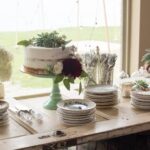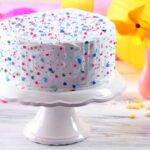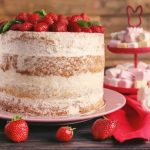Are you looking to learn how to easily decorate a cake? Cake decoration adds a special touch to any celebration, and knowing how to do it can elevate your baking skills to the next level. Whether it’s a birthday, wedding, or simply a gathering with loved ones, a beautifully decorated cake can become the centerpiece of any event.
The impact of a well-decorated cake goes beyond its visual appeal; it creates memorable moments that will be cherished for years to come. I still remember the awe on my grandmother’s face when she saw the intricately decorated cake at her 80th birthday celebration. It brought tears of joy to her eyes and added an extra layer of love to the event.
To embark on your own journey of creating stunning cake decorations, it is essential to have the right tools and ingredients. As we delve into this article, we will discuss necessary tools such as piping bags, tips, spatulas, and turntables. We’ll also explore key ingredients like fondant, buttercream, and edible decorations that are crucial for achieving professional-looking results in cake decorating. So let’s get started.
Necessary Tools and Ingredients
When it comes to decorating a cake, having the right tools and ingredients is essential for success. Whether you’re a beginner or an experienced baker, there are certain items that are crucial for creating beautiful and professional-looking decorations.
Essential Tools
Some of the necessary tools for cake decoration include piping bags, tips, spatulas, and turntables. Piping bags and tips are used for applying frosting and creating intricate designs, while spatulas are essential for smoothing out the frosting on the cake. A turntable makes it easier to frost the cake evenly and achieve a smooth finish.
Key Ingredients
In addition to tools, key ingredients such as fondant, buttercream, and edible decorations are necessary for cake decoration. Fondant can be used for covering cakes and creating detailed decorations, while buttercream is perfect for piping borders, flowers, and other designs. Edible decorations like sprinkles, edible glitter, and chocolate accents add extra flair to the finished product.
Quality Matters
It’s important to invest in high-quality tools and ingredients when decorating a cake. This will ensure that your decorations not only look great but also taste delicious. Using fresh ingredients and reliable tools will make the decorating process much more enjoyable and ultimately lead to better results.
By having the necessary tools and ingredients on hand, you’ll be well-equipped to tackle any cake decorating project with confidence. Whether you’re creating a simple birthday cake or an elaborate wedding cake, having the right supplies will set you up for success in creating stunning decorations that will impress your friends and family.
Choosing the Right Cake Base
When it comes to cake decoration, choosing the right cake base is crucial in ensuring that the decorations not only look beautiful but also complement the flavor and texture of the cake. The first consideration when selecting a cake base is the flavor – whether it be chocolate, vanilla, lemon, or any other variety. It’s important to choose a flavor that will pair well with the other ingredients and decorations that will be added to the cake.
The texture of the cake is another essential factor to consider. A moist and tender crumb is often preferred for cakes that will be decorated with fondant, as it provides a smooth surface for applying the fondant and prevents tearing or cracking. On the other hand, a more sturdy and dense texture may be suitable for cakes that will be adorned with elaborate buttercream designs.
In addition to flavor and texture, having a level and even cake surface is essential for successful cake decoration. Uneven layers can make it difficult to stack cakes or create smooth surfaces for frosting and fondant application. Using a serrated knife or leveling tool to even out each layer before assembling the cake can help ensure a professional-looking result.
By carefully considering these factors when choosing a cake base, decorators can set themselves up for success in creating stunning and deliciously balanced decorated cakes.
| Consideration | Importance |
|---|---|
| Flavor | Pairs well with other ingredients and decorations |
| Texture | Affects the ease of applying fondant or buttercream designs |
| Levelness | Ensures an even surface for stacking and decorating |
Preparing the Cake for Decorating
Once you have selected the perfect cake flavor and texture, it’s time to prepare the cake for decorating. This step is crucial in ensuring that your decorations go on smoothly and that the final product looks as professional as possible. The first step in preparing the cake is to level it.
Using a serrated knife or a cake leveler, carefully trim off any domed tops to create an even and flat surface. This will ensure that your cake layers stack neatly and won’t topple over once they are filled and decorated.
After leveling the cake, it’s important to fill and crumb-coat it. Spread your chosen filling, such as fruit preserves or flavored buttercream, between each layer of cake. Once stacked, apply a thin layer of buttercream around the entire cake to lock in any loose crumbs – this is known as the crumb coat.
After applying the crumb coat, chill the cake in the refrigerator for about 15-20 minutes. Chilling helps to firm up the buttercream, making it easier to apply a final coat without picking up any crumbs.
Once the crumb coat has chilled and set, you can then proceed with adding your final layer of frosting or fondant before decorating. With these essential steps completed, you can now be confident that your cake is ready for decoration.
Basic Techniques for Decorating
When it comes to cake decoration, mastering basic techniques is essential for creating beautiful and delicious treats. One of the most popular methods for decorating cakes is using buttercream, a versatile and easy-to-use frosting that can be piped into borders, flowers, and simple designs. To start, it’s important to have the right tools on hand, including piping bags, tips in various shapes and sizes, and offset spatulas for smoothing the frosting.
Another basic technique involves using fondant to cover cakes and create intricate decorations. Fondant is a pliable sugar paste that can be rolled out and draped over cakes for a flawless finish. It can also be molded into 3D decorations or cut into shapes for added flair. When working with fondant, it’s crucial to have a smooth and level cake surface to ensure a professional-looking result.
For those new to cake decorating, practicing these basic techniques is the perfect way to build confidence and skill. By starting with simple designs and gradually progressing to more intricate decorations, bakers can hone their abilities and discover their own unique style. With patience and practice, anyone can master these fundamental techniques and create stunning cakes that are sure to impress.
| Technique | Description |
|---|---|
| Buttercream Piping | Piping borders, flowers, and simple designs using buttercream frosting. |
| Fondant Covering | Using fondant to cover cakes for a flawless finish or creating intricate decorations. |
Advanced Decorating Techniques
When it comes to creating stunning cake decorations, mastering advanced techniques can take your skills to the next level. One technique to explore is using royal icing for intricate piping work and delicate designs.
Royal icing is made from confectioners’ sugar and egg whites, and it dries to a hard, glossy finish, making it perfect for creating detailed patterns and lace-like designs on cakes. Use a small piping bag with a fine tip to carefully pipe intricate designs onto the cake’s surface.
Another advanced technique to experiment with is creating 3D decorations. This can include modeling fondant or gum paste into shapes such as flowers, figurines, or other intricate designs. These 3D decorations can add depth and visual interest to your cakes, making them truly stand out at any celebration.
For those looking to add an artistic flair to their cake decorations, consider using edible paints and airbrushing techniques. With edible paints, you can hand-paint intricate designs directly onto fondant-covered cakes, while airbrushing allows you to create smooth color gradients and shading effects for a professional finish.
Enhancing your cake decorating skills with these advanced techniques will allow you to create show-stopping confections that are sure to impress at any event or gathering. Experimenting with different tools and methods will also help you find your own unique style as a cake decorator. By honing your skills in this way, you’ll be able to elevate your cakes from delicious desserts to works of art that every guest will admire.
Troubleshooting Common Decorating Issues
Solutions for Fondant Air Bubbles
One common issue when working with fondant is the formation of air bubbles, which can ruin the smooth appearance of the cake. To prevent this, be sure to roll out the fondant evenly and gently smooth it onto the cake surface. If air bubbles do appear, use a small pin to carefully puncture the bubble and then gently press the air out. Smooth the fondant over the puncture to blend it in with the rest of the surface.
Fixing Uneven Icing
Uneven icing can detract from the overall look of a beautifully decorated cake. To fix this issue, use a bench scraper to carefully smooth out any bumps or uneven areas on the cake’s surface. For buttercream icing, a hot offset spatula can help to melt and smooth out any imperfections. When working with fondant, gently use your hands or a smoothening tool to even out any rough spots.
Repairing Smudged or Uneven Decorations
If your delicate piping work or fondant decorations have become smudged or uneven, don’t panic. For buttercream decorations that need fixing, carefully scrape off the affected area and reapply fresh icing before piping again. With fondant decorations, gently remove the affected piece and reshape or recreate it as needed. Remember to handle all repairs with care to avoid additional damage to your beautifully decorated cake.
By being aware of these common decorating issues and how to address them effectively, you can ensure that your finished cakes look polished and professional every time.
Remember that troubleshooting is part of the learning process when it comes to cake decoration, so don’t be discouraged if you encounter some challenges along the way. Keep practicing and experimenting with different techniques in order to develop your skills and confidence as a decorator.
Finishing Touches and Presentation
After diligently decorating your cake with beautiful designs and intricate details, it’s important to add the finishing touches that will truly elevate the presentation of your creation. Here are some ideas for adding those final touches:
- Edible Glitter: Sprinkle a touch of edible glitter over the top of your cake to give it a dazzling, shimmering effect. This is especially effective for themed cakes or those designed for special occasions like weddings or anniversaries.
- Chocolate Accents: Create delicate chocolate accents such as curls, shavings, or even molded shapes to adorn the sides or top of your cake. Not only do they add a delicious element to your cake, but they also provide an elegant visual appeal.
- Fresh Flowers: For a natural and visually stunning presentation, consider adding fresh flowers to your finished cake. Choose blooms that complement the color scheme and theme of your decoration, ensuring they are free from pesticides and safe for consumption.
In addition to these finishing touches, don’t forget to pay attention to how you display the finished cake. Whether on a beautifully decorated stand or surrounded by complementary decorations, the way you present your cake can greatly impact its overall impression. Remember that presentation is just as important as taste and design when it comes to creating stunning cakes.
Conclusion
In conclusion, cake decoration is a wonderful way to add a personal and special touch to any celebration. Whether it’s a birthday, wedding, or any other milestone, a beautifully decorated cake can truly elevate the atmosphere and create lasting memories. By following the tips and techniques outlined in this guide, readers can confidently take on the challenge of creating their own stunning cake decorations.
With the right tools and ingredients at their disposal, along with a solid understanding of basic and advanced decorating techniques, readers can unleash their creativity and produce cakes that are not only visually appealing but also delicious. The step-by-step instructions provided in this article offer a solid foundation for mastering the art of cake decoration, empowering readers to experiment with different designs and materials.
Furthermore, I encourage readers to share their own creations and success stories with the author. There is nothing more rewarding than seeing the beautiful cakes that others have been inspired to create after reading this guide.
By connecting with fellow baking enthusiasts and sharing tips and ideas, we can continue to inspire each other on our cake decorating journeys. So go ahead, grab your tools and ingredients, and let your creativity shine through as you embark on your next cake decorating adventure.
Frequently Asked Questions
How Do You Decorate a Cake Quickly?
Decorating a cake quickly can be done by using simple techniques like spreading colored frosting on the cake, adding sprinkles or edible decorations, using a piping bag to create simple designs, or even arranging fresh fruit or flowers on top. The key is to work efficiently and have all your decorating supplies ready to go before you start.
How to Decorate a Cake for Cheap?
Decorating a cake for cheap can be achieved by using cost-effective ingredients and decorations like powdered sugar, cocoa powder, or even simple homemade frosting. Using creative alternatives like fresh fruit, chocolate shavings, or edible flowers can also add visual appeal without breaking the bank. Additionally, consider utilizing basic kitchen tools instead of specialized decorating equipment to save money.
How Do You Make a Plain Cake Look Nice?
To make a plain cake look nice, consider adding layers of flavor and texture with fillings like fruit preserves, custard, or flavored whipped cream between the cake layers. You can also create an attractive presentation by dusting the top with powdered sugar or cocoa powder, drizzling glazes over the surface, or adding a simple design with fresh fruit slices or chocolate curls.
Another option is to use different shaped pans for an interesting visual effect when the cake is sliced.

Welcome to my blog about home and family. This blog is a place where I will share my thoughts, ideas, and experiences related to these important topics. I am a stay-at-home mom with two young children. I hope you enjoy reading it! and may find some helpful tips and ideas that will make your home and family life even better!





